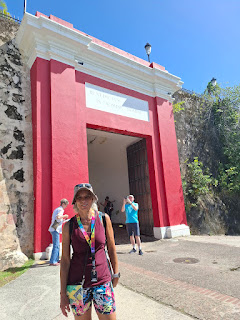Started to pour down with rain in our walking tour of San Juan, Puerto Rico so we sheltered in the highest bar on the waterfront and watched the rain. A sudden burst and 20 minutes later just as suddenly, out cam the sun accompanied by the heat.
The entrance to Old San Juan is known as Puerta de Aguas or Puerta de San Juan (San Juan Gate). It is one of the most colorful and known of all the entrances to the walled city and it has stood tall for centuries. The gate is 16 feet tall and 20 feet thick and leads you to the romantic Paseo La Princesa. The inscription above it reads “Benedictus Oui Venit In Nomine Domini” which translates to “Welcome those who come in the name of God,” a testament to the island’s Catholic roots.
Great ice cream at Anitas
He was initially tied to a post or tree and shot with arrows, though this did not kill him. He was, according to tradition, rescued and healed by Irene of Rome, which became a popular subject in 17th-century painting. In all versions of the story, shortly after his recovery he went to Diocletian to warn him about his sins, and as a result was clubbed to death. He is venerated in the Catholic Church and the Orthodox Church as the Patron Saint of Athletics, Archery, and Plagues. Although inconsistent with Catholic Church teaching, many view him as the patron saint of the LGBT Community, even though the saint himself has no ecclesiastical connection to the subject beyond a large body of homoerotic works of art
As the story goes, during the San Juan Bautista celebrations of 1753 a rider, Baltazar Montanez, lost control of his horse and plunged to the cliffs below. The Spanish Secretary of Government Don Mateo Pratts was watching the drama unfold from a nearby balcony, and allegedly cried out, “Christ of Good Health, save him!” Though the horse didn’t survive the fall, the young rider did.
That same year, Montanez built the small chapel on the exact spot where he fell over the cliff. The altar was built in shining silver and gold leaf, surrounded by beautiful oil paintings by the famous Puerto Rican artist Jose Campeche. Much of the modestly sized but immaculately appointed chapel hasn’t changed since then. But over the decades it has been slowly added to by believers who come to the chapel seeking their own miracles. Tiny silver ornaments decorate the chapel, each one representing some ailing part of the body. These small milagros, or miracles, represent a cause of pain for the pilgrims, and take the form of miniature silver legs, arms, hearts, and lungs.
Today the church is reverentially cared for by a group of local women, volunteers called “La Hermandad del Santo Cristo de la Salud” (The Sisterhood of the Holy Christ of Health). It is only open on Tuesdays and religious days.
Julia our Guide
A community of perhaps undocumented locals that have always lived in this prominent area are seen as an eyesore. The Government would like to turn the area into money generating Hotels.
From San Juan Bay, which was constructed to protect from attack, it’s an awesome feat of engineering and a daunting display of military defense featuring four levels of cannon-bearing batteries that rise 140 feet from the sea. From Old San Juan, the approach is more welcoming, thanks to an enormous expanse of grassy lawn and breathtaking views of the shore. It’s easy to see why this is such a popular spot for kite-flyers.
Inside Castillo San Felipe del Morro is a maze of rooms, including gun rooms, soldiers’ quarters, a chapel, turreted sentry posts, and a prison connected by tunnels, ramps, and a spiral stairway. The foundations for El Morro were laid in 1539, but it wasn’t completed until 1787. It successfully endured many foreign attacks by the English in 1595, 1598, and 1797, and by the Dutch in 1625. During the Spanish-American War, the United States fired on El Morro and destroyed the lighthouse, which was later rebuilt.
Castillo de San Cristóbal is the large fortress at the entrance to Old San Juan by Plaza de Colón. Before it was built, two significant attacks from land—first by the Earl of Cumberland in 1598, later by the Dutch in 1625—convinced the Spanish that protecting the walled city from attack by sea alone was not adequate.
The fort’s construction began in 1634 and was completed in 1783. The fort eventually encompassed 27 acres of land, although some of it was destroyed to accommodate the expanding city. The fort’s defense was tested in 1797 by another unsuccessful attack by the British. After the United States won the Spanish-American War, it took control of the fort and used it as a World War II observation post. Today, a section of the fort is open to the public, who can wander freely among its intriguing array of tunnels, ramps, stairways, batteries, magazines, soldiers’ quarters, and turreted sentry posts.

















No comments:
Post a Comment